ROBOTIS BT-210 THE BT-210 IS AN UART SERIAL MODULE IMPLEMENTING BLUETOOTH COMMUNICATIONS STANDARDS User Manual BT 210 guide us chase
ROBOTIS THE BT-210 IS AN UART SERIAL MODULE IMPLEMENTING BLUETOOTH COMMUNICATIONS STANDARDS BT 210 guide us chase
ROBOTIS >
User Guide

OEM Integrator manual
[BT-210]

Purpose
The BT-210 is an UART serial module implementing Bluetooth communications standards. The module can connect
to the following devices.
(please refer to each controller on how to mount the BT-210.)
• BT-210 : CM-100, CM-510, CM-530, CM-700, CM-900
[ examples of use]
• Ollo Bug control via Bluetooth communications
o Mount the BT-210 to the Bug’s controller (CM-100)
o Connect a smartphone to the BT-210 and control the Bug
• Control Bioloid Premium from a PC via Bluetooth
o Mount a BT-210 to the CM-900 then connect to PC serially
o Mount the BT-210 to Bioloid Premium’s controller (CM-510).
Set-up
• Connect the BT-210 to the CM-900 then run Tera Term.
• Connect the CM-900 to the PC via US; install drivers; Tera Term terminal uses the actual COM
port to connect ( pick any baud rate).
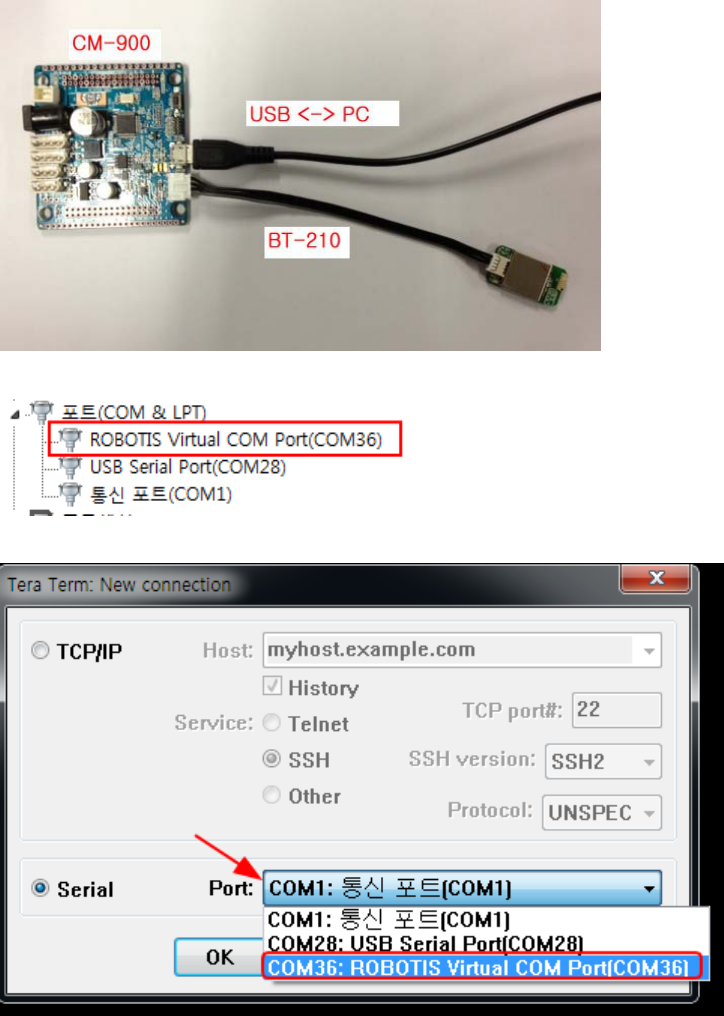
Setup is now complete. baud rate can be of any value.
<consult CM900_USB_드라이버설치.pdf for driver setup>

• Go to Setup -> Terminal check Local echo.
• From the terminal after AT input press the Enter key. With OK display then connection to BT-210
is successful.
• The BT-210 and CM-900 will connect in a SLAVE/MASTER configuration. The following
diagram is MASTER mode.
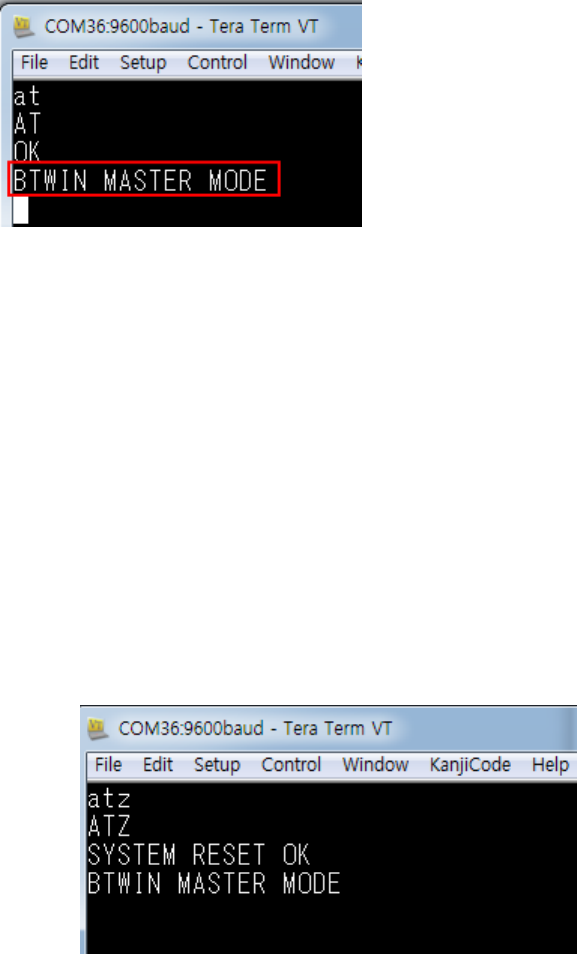
• Instructions types
From the terminal it is possible to change setup of the BT-210 via AT commands.
① System reset
ATZ resets the BT-210. Any changes made the command will reset to the change(s)
made.
② Mode change
Use the command below to change the mode of the BT-210 (Slave/Master).
AT+BTROLE=M -> Master mode

AT+BTROLE=S -> Slave mode
Then after ATZ command the system reset and mode change takes effect.
<MASTER mode>
<SLAVE mode>
③ Peripherals search
Peripherals search is possible only in Master mode. Enter the command AT+BTINQ
and Device Class 0x1F00(SPP) device peripheral will appear.
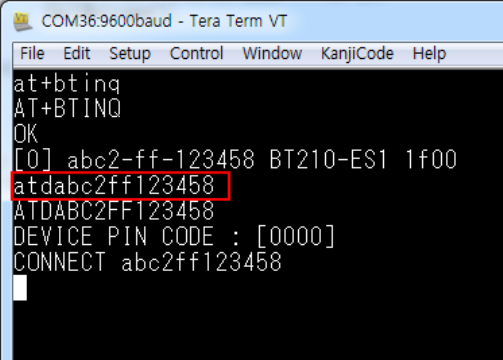
④ Connecting devices (pairing)
Enter the command AT+BTINQ to search for peripherals and the MAC address will
display (12-digit hexadecimal) then it can connect.
For example MAC address abc2-ff-123458appears on the terminal; enter the
command ATDabc2ff123458 and pairing will be attempted with the device with said
device. Look for the device pin code (default is 0000.).
⑤ Pin Code change
AT+BTKEY= 4-digit pin code
The illustration below shows how to change the pairing pin code.
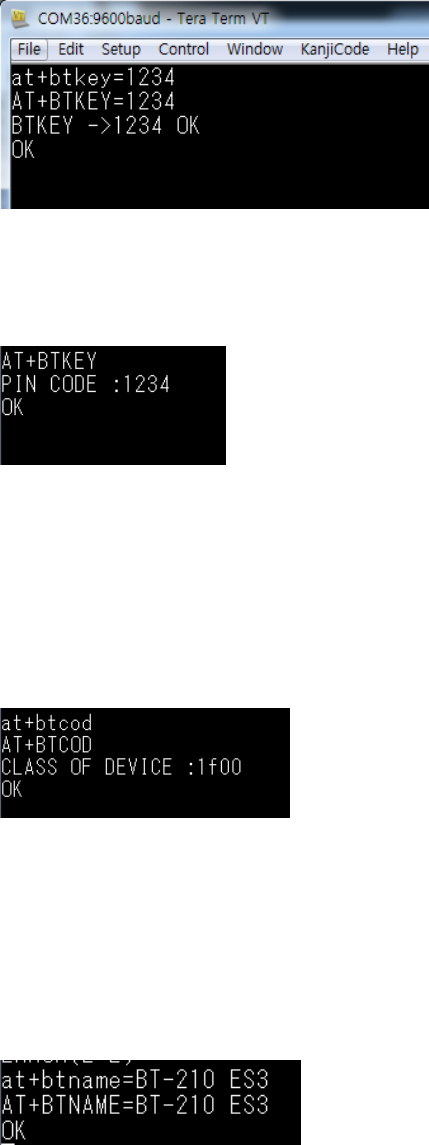
Simply enter the command AT+BTKEY (the = sign is unnecessary)
⑥ Current Device Class output
This is possible when the BT-210 is in SPP(Serial Port Profile) mode( 0x1f00).
⑦ Bluetooth device name change
Enter AT+BTNAME = to change name
⑧ Device Under Test mode (DUT)
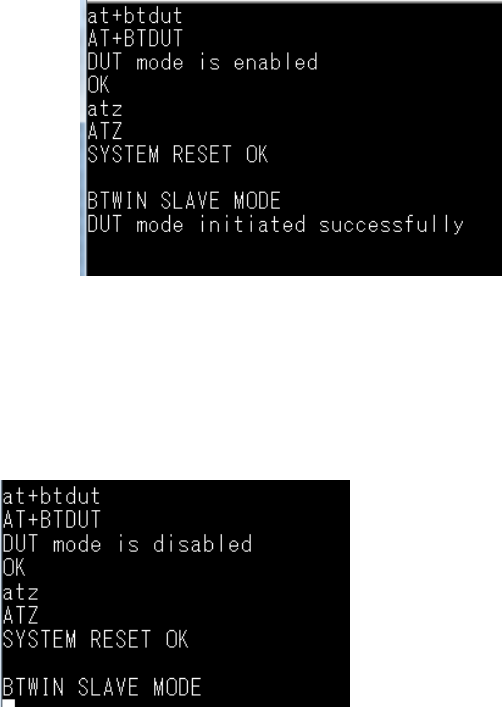
Bluetooth device performance can be measured in DUT mode.
Enter the command AT+BTDUT; the current mode will toggle. Enter ATZ and the
mode during toggle will be selected after a reset (note: this can only be done under
SLAVE mode only).
To exit DUT mode enter the command AT+BTDUT and DUT mode is disabled will display; enter
ATZ to reset.
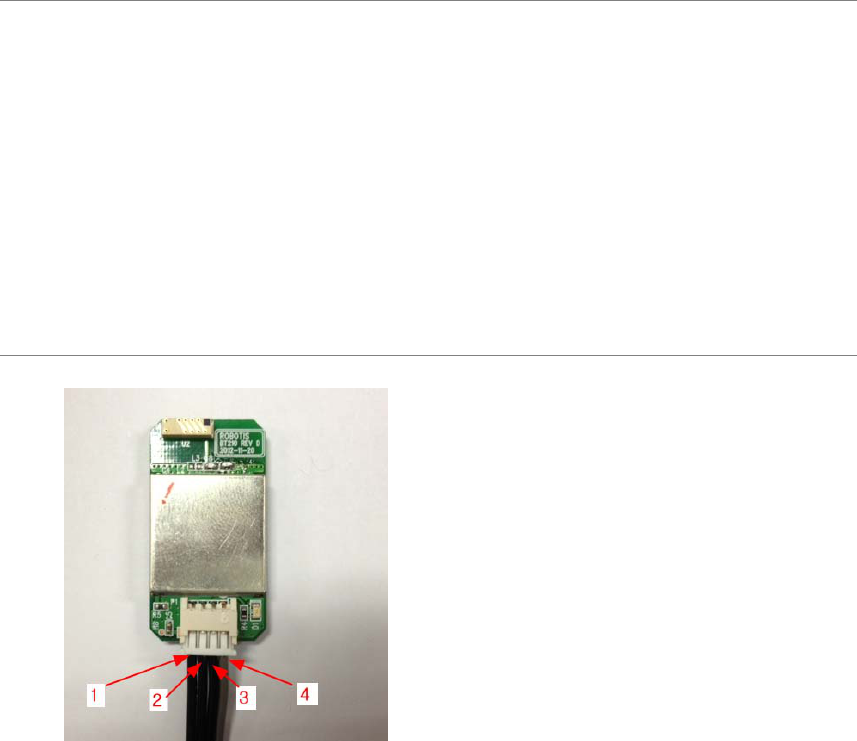
Communications mode
Besides pairing with the BT-210 1:1 communications is also reliable.
[ 1:1 communications ]
• Pair 2 Bluetooth devices (1 being the BT-210); one in MASTER mode (the other device) and the other in
SLAVE mode (BT-210).
• When powered on the LED will blink; after successful pairing the LED will remain constantly on.
Pin layout information
1. RXD : Bluetooth Module Receive Signal terminal
2. TXD : Bluetooth Module Transmit Signal terminal
3. VCC : Bluetooth Module Supply Voltage ( 3.3V )
4. GND : Bluetooth Module Ground Level (0v)

Hardware characteristics
• weight
o BT-210 : 5.7g
• size
o BT-210: 18mm * 30mm * 9.1mm
• Bandwidth: MAX 250kbps
• Operating voltage: 3.3V
• Current consumption: 48mA (MAX)
• Spectrum band frequency: 2.45Ghz ISM Band
• Transmission power: -6~4dBm(Class 2)
• Symbol/label:
ROBOTIS
FCC ID: SOD-BT-210
Model No.: BT-210
Rating: 3.3V , 0.2A
KCC-CRM-R0B-BT-210
Made In Korea
FCC Certification Requirements
This device complies with Part 15 of the FCC Rules.
Operation is subject to the following two conditions: (1) this device may not cause
harmful interference, and (2) this device must accept any interference received,
including interference that may cause undesired operation.
Note:
This equipment has been tested and found to comply with the limits for a class B digital
device, pursuant to Part 15 of the FCC Rules. These limits are designed to provide
reasonable protection against harmful interference in a residential installation. This
equipment generates, uses and can radiate radio frequency energy and if not installed
and used in accordance with the instructions, may cause harmful interference to radio
communications. However, there is no guarantee that interference will not occur in a
particular installation. If this equipment does cause harmful interference to radio or
television reception, which can be determined by turning the equipment off and on, the
user is encouraged to try to correct the interference by one or more of the following
measures:
-Reorient or relocate the receiving antenna
-Increase the separation between the equipment and receiver
-Connect the equipment into an outlet on a circuit different from that to which the
receiver is connected
-Consult the dealer or an experienced radio/TV technician for help.
CAUTION:
Changes or modifications not expressly approved by the party responsible for
compliance could void the user's authority to operate the equipment.

FCC Certification Guidelines for End Products Using the
BT-210
This module is limited to OEM Installation only.
1 Introduction
The BT-210 is a modular transmitter. Therefore, customers who wish to use the BT-210
Bluetooth in their end product must follow region-specific regulations.
This application note provides guidelines for the specific United States of America Federal
Communications Commission (FCC) that pertain to the BT-210. End products may be subject to
additional regulations, and it is the responsibility of the end-product manufacturer to determine
and comply with those regulations.
OEM integrators must be instructed to ensure that the end-user has no manual instructions to
remove or install the module.
This device complies with Part 15 of the FCC Rules. And FCC notice that grantee need to
provide guidance to the host manufacturer for compliance with the Part 15B requirements.
The end product with an embedded FCC ID:SOD-BT-210 Module may also need to pass the
FCC Part 15 unintentional emission testing requirements and be properly authorized per FCC
Part 15.
If need more information, please contact ROBOTIS .
2 Certification Overview
2.1 Unintentional vs. Intentional Radiation
The FCC require end products to comply with both unintentional and intentional radiation
regulations.
Unintentional radiation occurs from a product that inherently or unwillingly transmits RF signals.
Intentional radiation occurs from a product that is designed to radiate or transmit RF signals for
the purpose of wireless communication. The BT-210 is an intentional radiation emitter.
2.2 Modular Transmitter Approval
A modular transmitter is an intentional radiator device, such as the BT-210, that is designed to
be installed in a host device. Obtaining modular transmitter approval allows the modular
transmitter to be integrated into an end product without the need for additional intentional
radiation testing of the final end-product assembly, as long as the modular transmitter is
installed and operated in accordance with certain guidelines.
NOTE: Unintentional conducted and radiated emissions testing of the end product is still
required to ensure compliance with the rules governing unintentional radiators. It is the
responsibility of the end-product manufacturer to verify the end product meets these regulations.
Additionally, the customer is responsible for any and all tests and/or certifications pertaining to
their end product. This may include but is not limited to Specific Absorption Rate (SAR)
compliance and potential recertification as an intentional radiation emitter if the BT-210 is
installed or operated in a manner that differs from the instructions herein.
3. Compliance Guidelines
3.1 Overview
Modular approval permits the BT-210 to be integrated into an end product without the need to
recertify the end product as long as the following guidelines are followed by the module
integrator.
3.2 Integration Requirements
3.2.1 Antenna Systems
The BT-210 has been approved using the antenna and coaxial cable specified. Use of this
antenna and cable will satisfy FCC modular transmitter requirements. Substituting a different
antenna of the same type with a peak gain of 2.69 dBi or less at 2.4 GHz is permitted.
3.2.2 Substitute Antennas/Cables
If an antenna with a higher gain, of a different type, or with a shorter MCD/W.FL to MCB/U.FL
coaxial cable is used, the end product must be put through intentional radiation testing at a
qualified test lab.
Please refer to FCC rules 47 CFR § 15.204 for more information.
If a different is antenna is desired, please contact ROBOTIS for assistance with certification.
3.2.3 FCC Radiation Exposure Statement
This equipment complies with FCC radiation exposure limits set forth for an uncontrolled
environment. End users must follow the specific operating instructions for satisfying RF
exposure compliance.
Note1 : This module certificated that complies with RF exposure requirement under mobile or
fixed condition, this module is to be installed only in mobile or fixed applications.
A mobile device is defined as a transmitting device designed to be used in other than fixed
locations and to generally be used in such a way that a separation distance of at least 20
centimeters is normally maintained between the transmitter's radiating structure(s) and the body
of the user or nearby persons. In this context, the term “fixed location” means that the device is
physically secured at one location and is not able to be easily moved to another location.
Transmitting devices designed to be used by consumers or workers that can be easily re-
located, such as wireless devices associated with a personal computer, are considered to be
mobile devices if they meet the 20 centimeter separation requirement.
A fixed device is defined as a device is physically secured at on location and is not able to be
easily moved to another location.
Note2 : Any modifications made to the module will void the Grant of Certification, this module is
limited to OEM installation only and must not be sold to end-users, end-user has no manual
instructions to remove or install the device, only software or operating procedure shall be placed
in the end-user operating manual of final products.
Note 3 : The device must not transmit simultaneously with any other antenna or transmitter.
This device complies with Part 15 of the FCC Rules. Operation is subject to the following two
conditions: (1) this device may not cause harmful interference, and (2) this device must accept
any interference received, including interference that may cause undesired operation.
Caution : Changes or modifications not expressly approved by the party responsible for
compliance could void the user's authority to operate the equipment
IMPORTANT NOTE: In the event that these conditions cannot be met (for certain configurations
or because of co-location with another transmitter), the FCC authorizations are no longer
considered valid and the FCC ID certification number cannot be used on the final product.
In these circumstances, the OEM integrator will be responsible for re-evaluating the end product,
including the transmitter, and obtaining a separate FCC authorization.
3.3 Labeling Requirements for End-Product
The BT-210 has been certified by the FCC as a modular transmitter. As such, it has been
assigned an FCC ID that is printed on a label permanently affixed to the BT-210.
If the FCC ID label is not visible when the BT-210 is installed in the end product, this FCC ID
must be located on the exterior surface of the end product where users can easily access it.
The end product’s exterior label or etching should use wording similar to one of the examples
below.
■ Contains FCC ID: SOD-BT-210
■ Contains Transmitter Module FCC ID: SOD-BT-210
Please refer to FCC rules 47 CFR § 15.212(vi)(A) for additional information.
3.4 End-Product User Manual Statements
The following section outlines statements that are required to appear in the end product’s user
manual in order to maintain modular transmitter approval.
■ FCC User Manual Guidelines
For products marketed and used in the United States, the end-product user manual must
include the following caution statement in a prominent location:
To satisfy FCC RF exposure requirements for mobile and base station transmission devices, a
separation distance of 20 cm or more should be maintained between the antenna of this device
and persons during operation. To ensure compliance, operation at closer than this distance is
not recommended. The antenna(s) used for this transmitter must not be co-located or operating
in conjunction with any other antenna or transmitter.